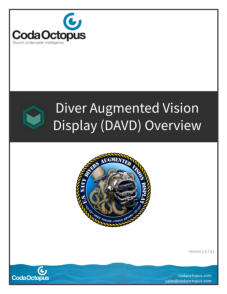Guidelines for the design and construction of
diving systems other than those of the IMO

This technical manual contains operation and
maintenance information and procedures for the US Navy
Lightweight Dive System (LWDS) MK 3 Mod 0 and for
components of the LWDS MK 3 Mod 1 that are common
to both systems.
Note that Lightweight Dive Systems US Navy are scuba
replacements.
Reference USN: SS500-HK-MMO-010
Date: 07 may 2003

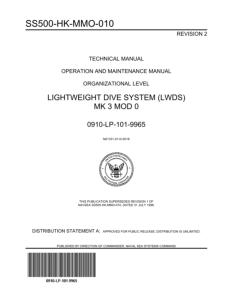

The standard US Navy double-Lock recompression
chamber system is a transportable chamber designed to
provide a means of recompression for diving operations,
including surface decompression of divers.
Reference USN: SS500-B1-MMO-010
Date: 22 March 2004

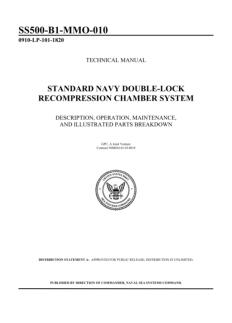

The solutions indicated in these guidelines are still those in
use in the diving industry.
Reference USN: SS521-AH-PRO-010
Date: 24 February 2005

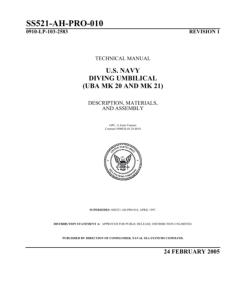

This document provides guidance, rules, and approaches
for designing a diving system according to the US Navy
requirements.
Reference USN: NAVSEATS500-AU-SPN-010
Date: 23 August 2006

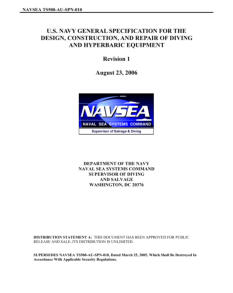

This report updates and expands the original work
published in part in 1998 under the title, "The Evolution of
Safety and Design Standards for Underwater Breathing
Apparatus". Proceedings of the 14th Meeting of the
United States-Japan Cooperative Program in Natural
Resources (UJNR), Panel on Diving Physiology, Panama
City, FL, 1997, U.S. Department of Commerce, NOAA,
National Undersea Research Program, Washington D.C.
Reference USN: 1945 TO 2015
Date: February 2915




The Naval Medical Research conducted hyperbaric
research in a Man-Rated Chamber Complex (MRCC)
originally installed in 1977
Significant engineering alterations to the MRCC and
rusting of some of its interior sections necessitated
repainting, which was completed in 1988. Great care
was taken in selecting an appropriate paint (polyamide
epoxy) and in ensuring correct application and curing
procedures. Only very low levels of hydrocarbons were
found in the MRCC atmosphere before initial
pressurization after painting and curing. After
pressurization. however, significant chemical
contamination was found...

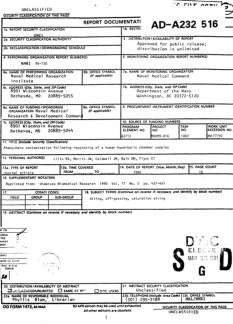

Authors: F. F. Leva, G. S. Goehring
US Navy recommendations for diving in contaminated
water included wearing a vulcanized rubber dry suit
mated to a MK 21 diving helmet to isolate the diver from
the contaminated environment. However, even in
situations (e.g., visible oil spills, noxious fumes, and sewer
outflows) where the need for protective gear is
unequivocal, thermal stress from working in a warm
environment often precludes the use of such gear. The
purpose of this study was to identify and evaluate a
commercially available diver cooling system through field
trials for overall effectiveness, comfort, durability, and ease
of use in and of incorporation into Navy diving practices.

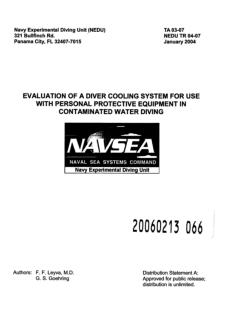

Authors: M. J. Swiergosz & R. J. Steckel
Resistive efforts, inhalation gas temperatures, and carbon
dioxide (CO2) canister and bottle durations were
measured from two Secondary Life Support (SLS) system
MK IV backpacks attached to the SLS helmet (Divex, LTD)
in simulated conditions. The resistive effort at 0 feet of
seawater (fsw) was assessed at three different backpack
orientations (00, 450, 900), and all of the dependent
measures were assessed at depth (1000 fsw) at the 450
orientation. A breathing simulator maintained a
respiratory minute volume (RMV) of 62.5 liters per minute
(L/min) throughout testing.

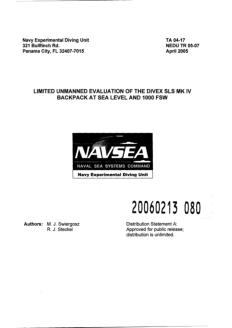

These Rules in association with the latest edition of the
ABS Rules for Building and Classing Steel Vessels (Steel
Vessel Rules), present the requirements for the
classification of underwater vehicles, systems and
hyperbaric facilities intended for use in manned
underwater operations

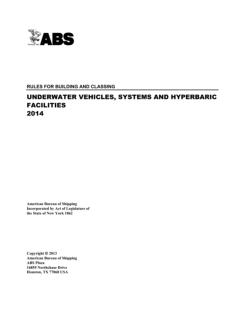

The present Note provides technical requirements for the
design, construction, testing and in-service surveys of
manned diving systems for which the class notations
defined in are granted.

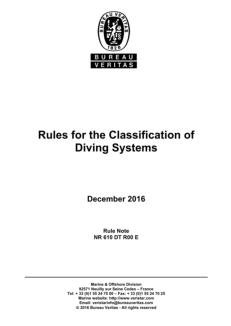

DNV GL rules for classification contain procedural and
technical requirements related to obtaining and retaining
a class certificate.
The rules represent all requirements adopted by the
Society as basis for classification.

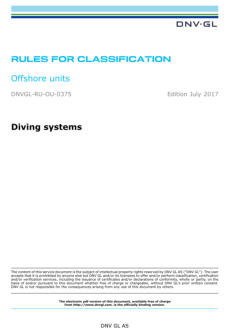

This document supersedes the June 2013 edition of DNV-
STC-2.7-1.
The purpose of the revision of this service document is to
comply with the new DNV GL document reference
code system and profile requirements following the
merger between DNV and GL in 2013. Changes mainly
consist of updated company name and references to
other documents within the DNV GL portfolio.

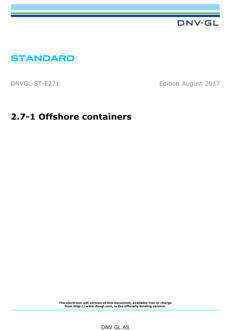

This Guide has been developed to provide requirements
for the certification of offshore containers with a gross
mass not exceeding 25,000 kg (55,116 lb), intended for
repeated use to, from and between fixed or floating
installations and ships.

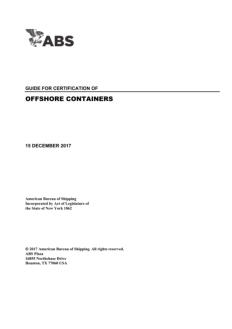

This document provides technical requirements for the
design, construction, testing and in-service surveys of
submersibles & diving systems.

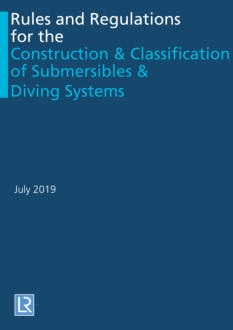

The January 2020 edition of the Rules for Building and
Classing Underwater Vehicles, Systems, and Hyperbaric
facilities incorporate all Rule Changes and Corrigenda
items since 2018. Requirements for underwater habitats
and complexes have been added.

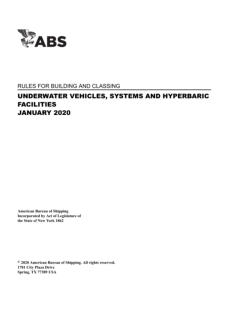

Authors: Ting C. Chou, Anthony Fiedorowicz.
Ten polymeric materials including EPDM, Nylon 6,6,
Buna-N, and other materials marketed as TFE-Teflon |
(PTFE), Kel-F 81 (PCTFE), Vespel | Spo21, Viton | A,
Viton | A-500, Fluorel | and Neoprene | were
systematically evaluated for their oxygen compatibility
property. The specific properties examined included:
Autoignition temperature (AIT), the heat of combustion,
and liquid oxygen (LOX) mechanical impact sensitivity.



This guide applies to metallic materials under
consideration for oxygen or oxygen-enriched fluid service.
It is concerned primarily with the properties of a metallic
material associated with its relative susceptibility to ignition
and propagation of combustion. It does not involve
mechanical properties, potential toxicity, outgassing,
reactions between various materials in the system,
functional reliability, or performance characteristics such as
aging, shredding, or sloughing of particles, except when
these might contribute to an ignition.

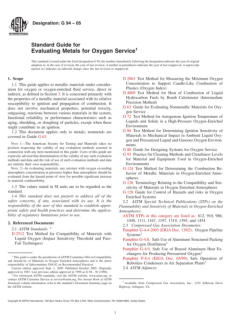

This guide applies to the design of systems for oxygen or
oxygen-enriched service but is not a comprehensive
document. Specifically, this guide addresses system factors
that affect the avoidance of ignition and fire. It does not
thoroughly address the selection of construction materials
for which Guides G63 and G94 are available, nor does it
cover mechanical, economic, or other design
considerations for which well-known practices are
available. This guide also does not address issues
concerning the toxicity of nonmetals in breathing gas or
medical gas systems.

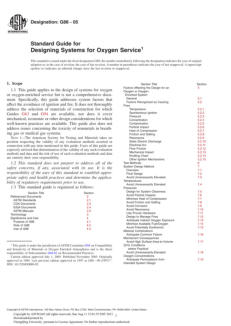

This guide applies to nonmetallic materials (hereinafter
called materials) under consideration for oxygen or
oxygen-enriched fluid service, direct or indirect, as defined
below. It is intended for use in selecting materials for
applications in connection with the production, storage,
transportation, distribution, or use of oxygen. It is
concerned primarily with the properties of a material
associated with its relative susceptibility to ignition and
propagation of combustion; it does not involve
mechanical properties, potential toxicity, outgassing,
reactions between various materials in the system,
functional reliability, or performance characteristics such as
aging, shredding, or sloughing of particles, except when
these might contribute to an ignition.

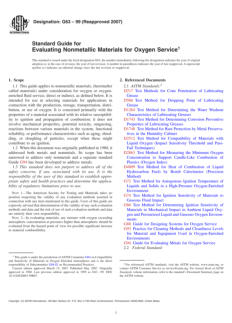

This guide covers an overview of the work of ASTM
Committee G-4 on Compatibility and Sensitivity of
Materials in Oxygen-Enriched Atmospheres. It is a starting
point for those asking the question: “Are there any
problems associated with my use of oxygen?”



The oxygen compatibility of six polymers used in oxygen
service was evaluated after 48 hr exposures at 121
degrees C (250 degrees F) to oxygen pressures of 620
and 6200 kPa (90 and 900 psi). Three elastomers were
tested: Choroprene rubber (C873-70), fluorocarbon
rubber (Viton), and silicone rubber (MVQ type); and three
thermoplastics were tested: polyhexamethylene
adipamide (Zytel), polytetrafluoroethylene (PTFE Teflon),
and polychlorotrifluoroethylene (Neoflon). Post-aged
changes in mass, dimensions, tensile strength, elongation
at break, durometer hardness, and thermomechanical
properties were evaluated.

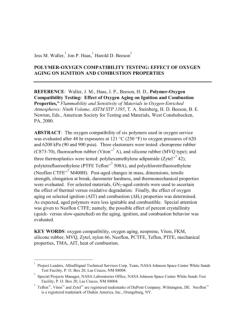

Authors: Mircea Horia Tierean, Liana sanda Baltes.
This paper presents the critical points in designing valves
used in reciprocating compressors. The design focuses on
valve type, dimensioning of the main elements, and
materials choice. The results obtained using
Computational fluid dynamics (CFD) and the method for
computing the centreline diameter of the rings and seats
to compensate for the thermal expansion during
operation are also explained.

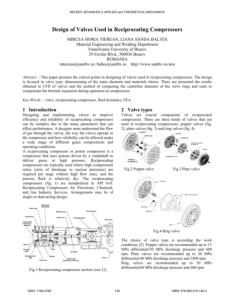

The US Navy Experimental Diving Unit (NEDU) is the
United States Navy facility for testing and evaluating
underwater breathing apparatus (UBAs). Each military or
commercial UBA that the US Navy considers for use is sent
to NEDU to assess its performance, material suitability,
human factors, and systemic reliability.

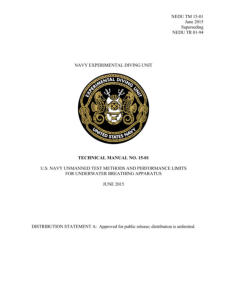

This US NAVSEA document provides courses and
reminders on electricity, electronics, Nuclear reactor work
principles, mechanic, chemistry, metals, and various
calculations. These courses are accessible to all levels.
Thus, it is appropriate for technicians and divers to keep it
in their data bank.

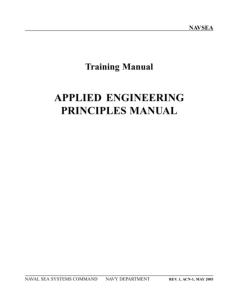

Authors: Sean Bishop, Keith Duncan, Helena Hagelin-
Weaver, Luke Neal, Jose Sanchez, Heather L.
Paul, and Eric Wachsman.
The partial electrochemical reduction of carbon dioxide
(CO2) using ceramic oxygen generators (COGs) is well
known and widely studied. However, complete reduction
of metabolically produced CO2 (into carbon and oxygen)
has the potential of reducing oxygen storage weight for
life support if the oxygen can be recovered.
The University of Florida developed novel ceramic oxygen
generators employing a bilayer electrolyte of gadolinia-
doped ceria and erbiastabilized bismuth oxide (ESB) for
NASA’s future exploration of Mars. The results showed that
oxygen could be reliably produced from CO2 at
temperatures as low as 400 degrees C.

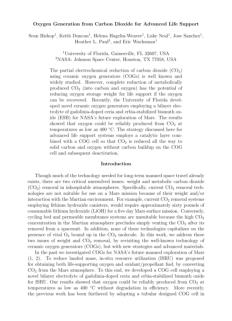

Authors:
Kevin R Ward, Gary S Huvard, Mark McHugh, Rajender R
Mallepally, and Richard Imbruce.
This paper provides a brief overview of the previous and
current attempts to utilize chemical oxygen production
strategies to enhance systemic oxygenation. While
promising, the routine use of chemically produced oxygen
continues to pose significant engineering and physiologic
challenges.



Authors:
Hanna Kierzkwska-Pawlak, Andrzej Chacuk.
The mass transfer rates during CO2 absorption and
desorption from DMEPEG* solutions were measured at a
temperature ranging from 293.15 to 323.15 K in a baffled
agitated reactor with a flat gas-liquid interface operating in
a batch-wise manner. The desorption rate was
determined and compared with the absorption rate at the
same driving force based on the measured values of
pressure changes.
*DMEPEG is a prominent solvent for absorbing both H2S
and CO2.



This NAVSEA approved procedure provides the minimum
US Navy requirements for paint removal, surface
preparation, repainting and air sampling of the interior of
Navy Steel & Stainless Steel Portable or
Afloat Recompression Chamber Systems using Formula
150 Primer and 152 Topcoat White in accordance with
MIL-DTL-24441D.

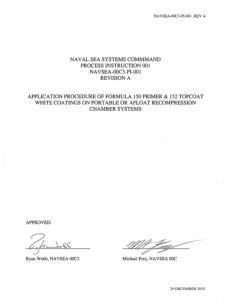

Authors:
Asterios Kosmaras, Dimitrios Tzetzis, Panagiotis Kyratsis.
This paper discusses the design of an oxygen regulator for
medical use. Its conceptual design procedure starts with
research on the main elements, the pressure regulator's
operating principles, and the existing technologies. The
sizing guidelines and the essential calculations to be
made are also discussed. The features discussed in this
document should be considered for the conception and
implementation of oxygen diving regulators.

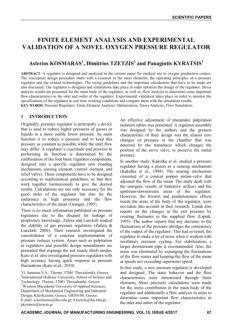

Authors: Micheal Wolf, & Petr Eret.
This master thesis regarding the conception of
reciprocating compressor valves explains that these parts
are essential as their failure leads to shutdown and costly
downtimes. For this reason and because they are highly
solicited, the author explains that designers have to bear
in mind that these parts must be reliable and be able to
operate efficiently in adverse conditions, such as when
liquids and debris are in the gas stream.

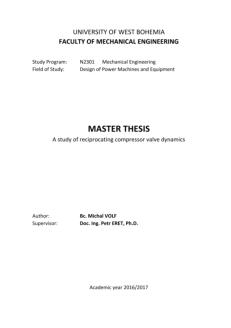

Authors:
Lei Shao, Guoliang Xie, Cheng Zhang, Xiao Liu, Wanran
Lu, Guangyu He, and Jinfeng Huang.
Metal combustion is one of the main issues threatening
service safety in oxygen-enriched atmospheres. This paper
reviews the recent development of metal combustion in
oxygen-enriched atmospheres. Test methods under three
standard conditions and combustion behaviors of three
typical metals are mainly discussed. The future
development trend of metal combustion in oxygen-
enriched atmospheres is also forecasted.

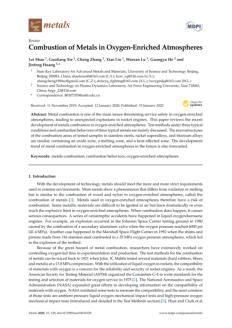

Authors: Anas Obeidat, Thomas Andreas, Stephane P.A.
Bordas, & Andreas Zilian.
Gas-dynamic pressure surges and adiabatic compression
phenomena are generally hard to predict numerically. In
this contribution, the authors studied the effect of the
pressure reserve capacity on the compressible gas-
dynamics pressure surge and adiabatic compression in a
fitted respirator oxygen valve geometry.

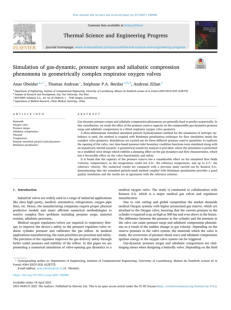

The Executive Board of the “Undersea and Hyperbaric
Medical Society Associates” authorized the organization of
a committee to develop a set of facility design
recommendations for clinical hyperbaric facilities. This
document is the work published by this committee.

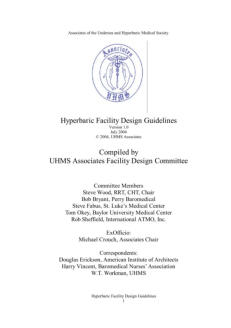

Authors: Thomas L. Reynolds, Thor I. Eklund, and Gregory
A. Haack
This document analyses oxygen systems from either
compressed oxygen gas cylinders or solid chemical
oxygen generators designed for use on commercial
transport aircraft. It allows a better comprehension of the
advantages and inconveniences of both systems that can
be considered for selecting means of oxygen delivery
during an emergency.



Author: Timothy L. Ward
This project addresses the need for reliable fabrication
methods of dense ceramic membranes for oxygen
separation. Some ceramic materials that possess mixed
conductivity (electronic and ionic) at high temperatures
have the potential to permeate oxygen with perfect
selectivity, making them very attractive for oxygen
separation and membrane reactor applications. To
maximize permeation rates at the lowest possible
temperatures, it is desirable to minimize diffusional
limitations within the ceramic by reducing the thickness of
the ceramic membrane, preferably to thicknesses of 10
µm or thinner.

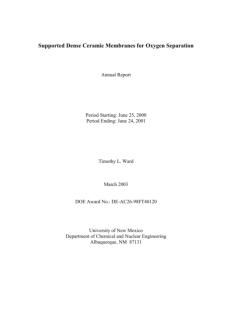

Authors: Justin Brady, Travis Spain, Brent Shambaugh
This project is intended to produce a device that can
deliver therapeutic oxygen supplement to persons
suffering from Chronic Obstructive Pulmonary Diseases
(COPD) and other ailments of the pulmonary tract. The
device is to be portable with the capacity to deliver a
stream of nearly pure oxygen at a rate of 5 L/min.

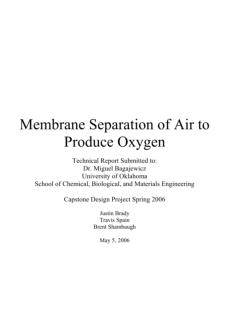

Authors: Jiang Dongsheng, Bu Xueqin, Sun Bing, Lin
Guiping, Zhao Hongtao, Cai Yan, Fang Ling
The present paper studies the ceramic membrane
technology for onboard oxygen generation. Comparisons
are made to know the effects of two ceramic membrane
separation technologies on oxygen generation: electricity-
driven ceramic membrane separation oxygen generation
technology and pressure-driven ceramic membrane
separation oxygen generation technology.



Authors: Thomas C. Blakeman; Dario Rodriquez Jr.; TSgt
Tyler J. Britton; Col Jay A. Johannigman; Lt Col
Michael C. Petro; Richard D. Branson.
Oxygen cylinders are heavy and present several hazards,
and liquid oxygen is too heavy to be used in far forward
environments. Portable oxygen concentrators (POCs) and
chemical oxygen generators (COGs) have been proposed
as solutions. The authors evaluated three commercially
available Portable oxygen concentrators and three
chemical oxygen generators in a laboratory. Altitude
testing was done at sea level and 8,000, 16,000, and
22,000 ft. Temperature extreme testing was performed
after storing devices at 60°C and − 35°C for 24 hours.

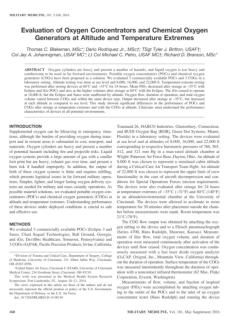

Author: John Graf
As submarines were required to accomplish longer and
longer submerged periods of operation, the need to
manage normal and emergency life support supplies
became a priority. Sodium chlorate candles are a very
efficient means of storing oxygen with a mass of oxygen
per unit of volume greater than compressed oxygen. The
volume efficiency of candles is almost equal to that of
liquid oxygen without the dangers and equipment issues
of cryogenic storage. These devices are known by several
names: Oxygen Candles, Chlorate Candles, SCOG (either
Solid Chemical Oxygen Generator or Self-Contained
Oxygen Generator) and SFOG (pronounced "S-FOG,"
Solid Fuel Oxygen Generator).



IMO has issued MSC/Circ.860 Guidelines for the approval
of offshore containers handled in open seas. This circular
is intended to assist the competent authorities in
developing the requirements for approving the offshore
containers. IMO requires that all intermodal containers
conform to the requirements of the International
Convention for Safe Containers (CSC). The requirements
of the CSC convention may not be applicable to offshore
containers primarily due to non-standard designs,
exposure to the marine environment for extended
periods as well as the lifting of offshore containers by
padeyes. EN 12079 has been published based on the
MSC/Circ.860 and is currently used as an International
industry standard to approve offshore containers

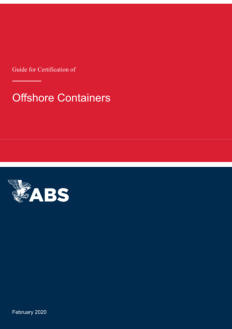

Authors: Francesca Drago, Paolo Fedeli, Angelo Cavaliere,
Andrea Cammi, Stefano Passoni, Riccardo Mereu,
Stefano De La Pierre, Federico Smeacetto, and
Monica Ferraris.
The integration of oxygen transport membranes in
industrial processes can lead to energy and economic
advantages, but proof of concept membrane modules are
highly necessary to demonstrate the feasibility of this
technology. In this work, the authors describe the
development of a lab-scale module through a
comprehensive study that takes into consideration all the
relevant technological aspects to achieve a prototype
ready to be operated in industrial environment.

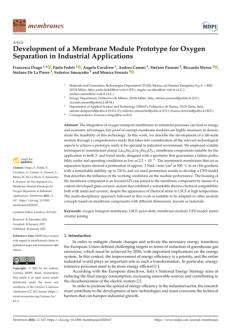

Author: Valerie Flook
“Unimed Scientific Limited” was contracted to lead the
development of a suitable monitoring device that would
alert the divers of the presence of volatile hydrocarbons
from condensate accidentally brought back to the bell.
The project was funded by a consortium of companies
and organizations concerned with the offshore oil
industry. This document is to be taken as the reference
regarding the comprehension of the ANALOX Hyper-Gas
Diving Bell Monitor.

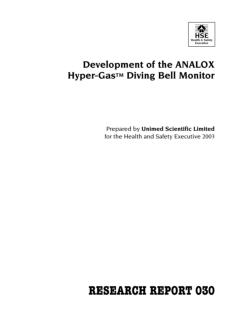

Authors:
Martin DJ Sayer, Elaine Azzopardi and Arne Sieber
Single examples of 43 models of dive computer were
compressed to five simulated depths between 15 and 50
metres sea water (msw) and maintained at those depths
until they had registered over 30 minutes of
decompression. At each depth, and for each model,
downloaded data were used to collate the times at which
the unit was still registering “no decompression” and the
times at which various levels of decompression were
indicated or exceeded. Each depth profile was replicated
three times for most models



Authors:
Salih Murat Egi, Pierre-Yves Cousteau, Massimo Pieri, Carlo
Cerrano, Tamer Özyigit, and Alessandro Marroni
Dive computers have an important potential for citizen
science projects where recreational SCUBA divers can
upload the depth temperature profile and the geolocation
of the dive to a central database which may provide
useful information about the subsurface temperature of
the oceans.
However, their accuracy may not be adequate and needs
to be evaluated. The aim of this study was to assess the
accuracy and precision of dive computers and provide
guidelines in order to enable their contribution to citizen
science projects.

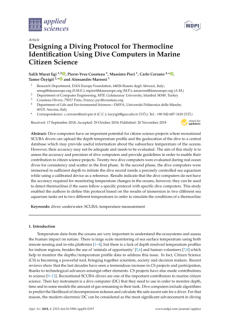

Authors:
Miraç Memisoglu, amer Özyigit, Seçil Satir, Salih Murat Egi
Diving computers on the market are based on embedded
systems where the user cannot reprogram the units
except entering limited number of dive parameters such
as the content of cylinders and the conservatism of the
computation.
An innovative system is designed and patented by the
authors for implementing a diver carried computer using a
mobile phone inside a pressure and waterproof housing
in combination with an
external microcontroller based electronic module.

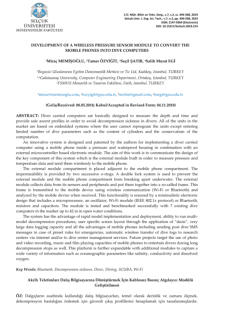

Author: Y Yasemin
Hydrogen sulfide is a highly toxic gas and must be
removed from where it is found or formed. A promising
technique to achieve this is chosen. The aim of this study
was to develop a membrane that holds the gas in
processes and places where H2S can occur and in order
to prevent possible threats.
The membrane was prepared by loading copper sulfate
into a polymeric resin with mechanical mixing.

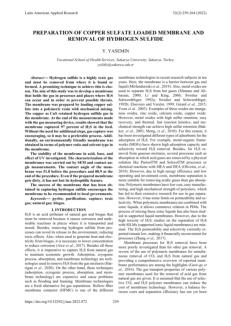

Author: Stephen Butler
High-pressure gas cylinders (also called tubes) are certified
for continued use once they pass their periodic inspection
and test. The previously accepted practice for testing the
cylinders was the hydrostatic proof test, known as ‘hydro
test’, where water is introduced before it is pressurized to
the cylinder’s test pressure, commonly one and a half
times the operating pressure.
The problems caused by the hydro testing of high-
pressure gas cylinders in offshore vessels include concerns
over safety, the long time required to complete the tests,
and the expense. On the opposite, acoustic emission (AE)
testing is claimed to be faster, cheaper, and safer.

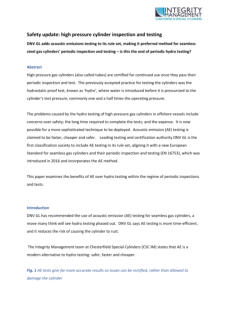

Author: Karl E. Huggins
Dive computers are standard pieces of equipment in
recreational, scientific, and military diving. However, many
commercial diving regulations state that they cannot be
used to determine decompression status. The dive
computer’s ability to continually update decompression
status results in more efficient use of dive time. Because
few human subject studies have been performed to
validate dive computer decompression algorithms, there
needs to be a method to evaluate the associated
decompression risk for commercial diving use. This
evaluation protocol would approve, or reject, specific
decompression algorithms.

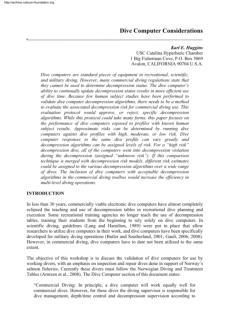

Authors:
David B. Kynor, William E. Audette
The goal of this project was development of a Diver
Health Monitoring System (DHMS). The DHMS will
provide a powerful capability for real-time monitoring of
the electrocardiogram and other key physiological
parameters during diving. The system evolves the concept
of the current dive computer into a physiological monitor
capable of measuring the diver's critical "vital signs" and
ultimately predict impending problems (e.g.. hypothermia
and excessive fatigue).

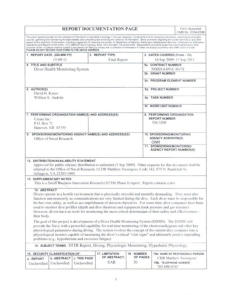

Authors:
Andreas Schuster, Olivier Castagna, Bruno Schmid, Tobias
Cibis, and Arne Sieber
A new device was developed and tested in a series of
diving experiments investigating the physiological effects
of immersion on military divers for long periods (8 h to 12
h). During these experiments, the body temperature
(core and skin) and electrocardiogram (ECG) of the divers
were recorded and monitored in real time.

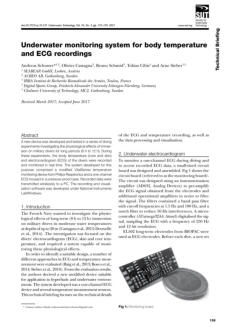

Authors: Nicusor Chiripici, Amil Avram, Laurentiu Mocanu
The risks of radioactive water contamination are high
today and divers can make a decisive contribution to
removing these risks.
The equipment used and the diving procedures are
specific.
The specialists of the Research Laboratory, in collaboration
with those of the Hyperbaric Laboratory of the Diving
Center from Constanta, have contributed to the
development of this equipment and the diving
procedures in the radioactive contaminated environment.

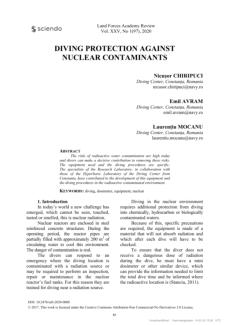

Authors: Eftedal O., Mohammadi R, Rouhani M., Torp, H.,
Brubakk A.O.
The authors developed a system for real-time detection
and quantification of intravascular gas bubbles. The
system is based on computer processing of video signals
of echo eardiographic images. Images from any
ultrasound scanner can be used, provided a standard PAL
video signal is available.
The detection program is a stand-alone application for
Macintosh computers, and the only additional hardware
requirement is a commercially available video frame
grabber card for digitisation of the video signal.

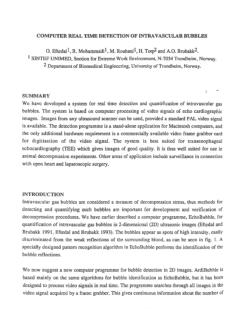

Authors: Cunningham, S., Burke, A., Kelly,
This document describes the development of a transient
model of a Closed Circuit Rebreather to investigate the
effects of several key parameters affecting rebreathers'
scrubbers' performance: geometry, wall temperature,
velocity, and CO2 absorption granule size and material
selection on the breakthrough of the CCR scrubber,
where breakthrough is defined as the time until the CO2
exhausted from the scrubber canister is the same as that
going in.

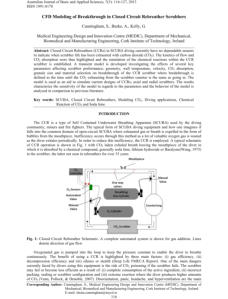

Authors: Jinming Tian, Yue Zeng, Linhai Ji, Huimin Zhu
and Zu Guo
To meet the latest requirements for sensor quality testing
in the industry, the sample sensor needs to be placed in a
medium for the cold and hot shock tests. However, the
existing environmental test chamber cannot effectively
control the temperature of the sample in the medium.
This paper presents a control method that utilizes the
support vector machine (SVM) classification algorithm and
K-means clustering, combined with neural network
correction.

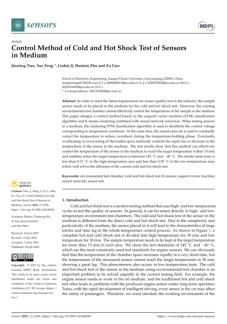

Authors: Arnaud Druelle, Lucille Daubresse, Jean U
Mullot, hélène Streit, Pierre Louge
Without an adequate supply of oxygen from the scuba
apparatus, humans would not be able to dive. The air
normally contained in a scuba tank is dry and free of toxic
gases. The presence of liquid in the tank can cause
corrosion and alter the composition of the gas mixture.
Various chemical reactions consume oxygen, making the
mixture hypoxic. The authors present two cases of internal
corrosion in scuba cylinders resulting in the respired gas
becoming profoundly hypoxic, which caused immediate
loss of consciousness in divers.

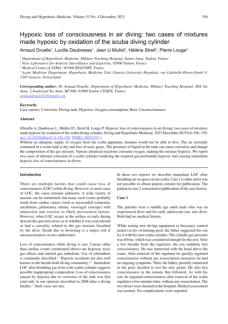



Click on the
octopus to return to
the top of the page

Authors: T. Vu Quoc, H. Nguyen Dac, T. Pham Quoc, D.
Nguyen Dinh, T. Chu Duc
This paper introduces a three-electrode capacitive fluidic
sensor designed to detect air bubbles in fluidic channels
such as blood vessels, oil pipes, or medical liquid channels.
The sensor is fabricated on a printed circuit board (PCB)
with electrodes made from copper via structures
extending from the top to the bottom surface of the PCB.
A plastic pipe runs through the capacitive sensor and is
positioned perpendicular to the PCB surface.

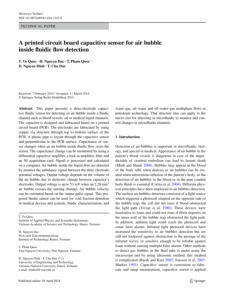

Author: Ryszard Klos
This paper is the result of extensive work and numerous
research projects. During these projects, a new
mathematical model for ventilating a semi-closed
rebreather was developed. To validate this model, a
simulator was created to mimic gas exchange during
breathing. This device allowed for the experimental
validation of our proposed model. The model was also
adapted to suit the ventilation processes in hyperbaric
chambers.

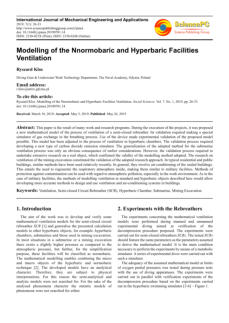

Author:
Ryszard Kłos - Polish Naval Academy, Department of
Underwater Work Technology, Poland
This article continues our series on diving technology
design, answering questions from readers and users
about the systems discussed previously. It also covers the
recent NATO Working Group meeting debates, where
the Polish team showcased various decompression
methods.

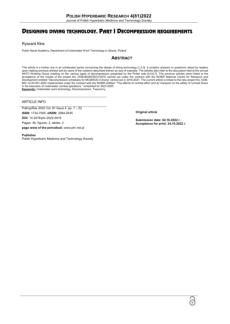

Authors: Lyubisa Matity, Francois Burman, Jacek Kot,
Joseph Caruana
Hyperbaric chamber ventilation (HCV) involves pumping
fresh gas, such as air, oxygen, or heliox, into a pressurized
hyperbaric chamber to clear out stale or contaminated air.
The minimum continuous HCV rate is usually determined
based on mathematical models that balance the mass of
contaminants in a well-mixed space. However, these
models might not always be reliable if the distribution of
contaminants inside the chamber is not uniform.


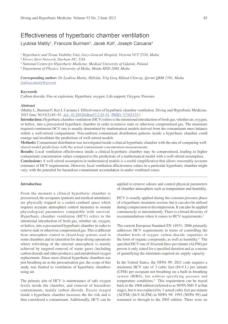

Authors:
Ding-Yu Fei, Xiaoming Zhao, Cosmin Boanca, Esther
Hughes, Ou Bai, Ronald Merrell, Azhar Rafiq
This document describes the development, testing, and
validation of an embedded biomedical sensor system
designed to monitor astronauts' physiological parameters
in real-time during extravehicular activities (EVA) in space
exploration. It outlines the project's objectives, methods,
results, and conclusions, emphasizing the system's
successful integration and functionality in NASA field tests.

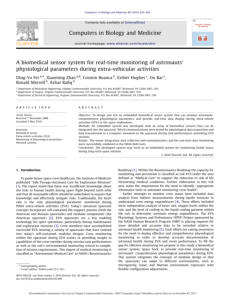

Authors:
A. Afaneh, S. Alzebda, V. Ivchenko, & A. N. Kalashnikov
The authors of this document describe and compare two
different ultrasonic measurement approaches for
determining temperature in aqueous solutions. They detail
both approaches' methodologies, experimental setups,
and results, highlighting their sensitivity, accuracy, and
advantages over conventional thermometers.



Author: Tye Langston, Shane Singh, and Jeffrey Hunt
This study measured and analyzed the noise
characteristics of a commonly used diving helmet, the
Kirby Morgan 37, under various simulated diving
conditions to understand how different factors such as
depth, breathing rate, and type of breathing gas affect the
noise levels experienced by divers, and to highlight the
potential impact on divers' hearing health.

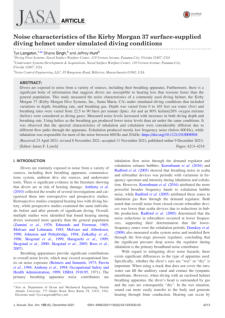

Author: Coda Octopus
This document describes and promotes the features and
capabilities of the Diver Augmented Vision Display
(DAVD) system. It informs potential users, such as dive
supervisors and divers, about the advanced functionalities
of the DAVD system, including its high-resolution head-up
display, real-time 3D imagery, communication capabilities,
and its applications in various diving scenarios. It highlights
the benefits of the system in enhancing diver safety,
efficiency, and mission outcomes through advanced
technology and seamless surface-to-diver communication.

